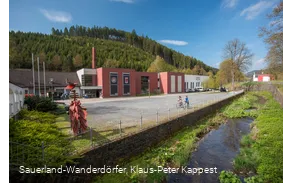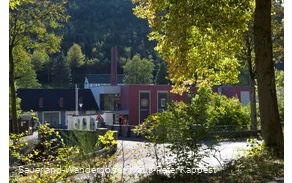Museumsplatz Eslohe
Eslohe, Homertstr. 35 (51.26191 | 8.165718)
Anarchy and humility
Outdoor area of the DampfLandLeute Museum with hydroelectric power plant, tracks and machines.
Nothing fits together here. And it fits really well. Sounds contradictory? That's exactly the point. About contradictions. In the character of the man who shaped this place; in the spirit of every person with their different voices; as a challenge that we sometimes despair of.
But one thing at a time. I am standing on the forecourt of the DampfLandLeute Museum in Eslohe on a sunny April day and thinking about the dazzling figure who left his architectural mark on it. Eberhard Koenig was the owner of the chain factory that later became the museum. He managed the company for half a century, lived on the premises for 20 years and his urn was buried next to the house in 1981.
Excuse me, a grave in the garden? Is that even allowed? Not really. Which brings us to the first contradiction. Koenig had influence in Eslohe. Successful businessman, largest employer, benefactor in many ways. From this position, he allowed himself liberties that would have been hard to resent for normal citizens. This included the fact that he, the rich factory owner, put on overalls, helped out in production and enjoyed a drink with his workers at the end of the day. Or even a few glasses more. Until he fell seriously ill. Then he completely changed his ways and became a teetotaler. Is it a coincidence that he, who had previously entertained the idea of handing the company over to his workers, now distanced himself from them and acted like a reclusive patriarch?
I look around the forecourt. Koenig's ambivalent personality is reflected in the hodgepodge of architectural styles. White-painted arcades are reminiscent of monastic cloisters, but have no other function than to delimit the grounds. The residential building plays with the contrast between the simplicity of the 1960s and - through a round tower - monarchical splendor. The windows of the adjoining workshop would also have looked good in a church. The double-leaf gate to the former workshop does not have an industrial look, but looks like a typical Sauerland barn door with its green and white diamond pattern. An old, carefully restored factory locomotive with steam drive stands next to it in direct contrast. In the moat above the hall, the reflections of the towering red factory chimney clash with the black and white half-timbered pattern of former workers' houses. Loosely based on a well-known book title: What kind of place is this, and if so, how many?
The morning sun is warming. I sit down on a bench next to the factory barn door, a carpet of bright yellow dandelion flowers in front of me, and think about contradictions in my own life. Somehow, my mind seems to effortlessly manage to think about climate protection on a flight to South Africa; to eat another fast-food hamburger on the way back from the organic food store; to complain about the "fucking arrogance of this colleague..." - and not realize how arrogant I am at that moment. It all goes together perfectly in my head. Just like on the pitch in front of me.
Eberhard Koenig, who could have afforded an outside cabin on luxurious cruise ships for his world travels, instead sailed as a stoker on merchant ships, for example to China. First debauchery, then asceticism. First a wealthy sympathizer of socialist ideas, then a suspicious factory owner. On the one hand a packer with oil-smeared hands, on the other a beautiful thinker who welcomed the writer Günter Grass for political chats.
When he died, the waterwheel next to his house mysteriously stopped. For decades, it had been reliably turned by the Salwey flowing past. One last incomprehensible moment. Koenig left the community a foundation with millions in capital, a unique collection of steam engines for those interested in technology and a place of the soul full of contradictions and suspense. He invites us to reflect on why we humans can never fully explain our inner contradictions to ourselves. Koenig has left behind a wise sentence. He had a copper plate attached to one of the arcades, the inscription of which is covered in a greenish patina: "Don't blame what you can't understand."
Author: Michael Gleich
Museumsplatz Eslohe
Wheel and rail,
Companions of mankind's progress,
The future is rooted in the past
Insight in the now, inspiration, will, courage
Drive for development,
at their side tears for setbacks
and jubilation for successes
set the course today for tomorrow,
when today becomes yesterday,
we know the value of progress
ambivalent for heaven as well as for hell
Marlies Strübbe-Tewes
He invites us to reflect on why we humans can never fully explain our inner contradictions to ourselves.
Michael Gleich






